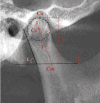Comparison of temporomandibular joints in relation to ages and vertical facial types in skeletal class II female patients: a multiple-cross-sectional study
- PMID: 38632555
- PMCID: PMC11022430
- DOI: 10.1186/s12903-024-04219-4
Comparison of temporomandibular joints in relation to ages and vertical facial types in skeletal class II female patients: a multiple-cross-sectional study
Abstract
Background: The temporomandibular joint (TMJ) is closely related to the dynamic balance and stability of mandibular function and orthodontic treatment. Skeletal class II female patients are thought to be at high risk for TMJ disease. The relationship between the TMJ and craniofacial structures is still controversial. This study compared the morphology and position of the TMJ in skeletal class II adolescents and adults with various vertical facial types using cone-beam computed tomography (CBCT).
Materials and methods: A total of 117 skeletal class II patients were divided into three groups according to the FH-GoGn angle (hypodivergent, normodivergent and hyperdivergent), with 40 class I normodivergent patients serving as controls. Each group contained two age subgroups (adolescents: 11-14 years old, adults: 18-35 years old). The size (condylar length, height, long and short axis diameter, glenoid fossa width and depth) and shape (condylar neck inclination, condylar head angle and long axis angle, articular eminence inclination) of the condyle and fossa, joint space (anterior, superior, posterior, mesial and lateral), and position of the fossa (vertical, transverse, and anteroposterior distance) and condyle were measured and compared using CBCT.
Results: Class II hypodivergent patients exhibited the greatest condylar length, height, and long- and short-axis diameter; steepest articular eminence; deepest fossa depth; largest superior, mesial and lateral joint spaces; and highest fossa position in both age groups. The manifestations of class II hyperdivergent patients were mostly the opposite. In adults, except for the condylar long axis angle, the measurements of the condyle increased differently among skeletal patterns, while the measurements of the fossa decreased, as the joint spaces and fossa position remained approximately stable compared with those in adolescents.
Conclusion: The vertical skeletal pattern, rather than the class II sagittal skeletal pattern, may be the main factor affecting the morphology and position of the TMJ. Attention should be given to the TMJ area in hyperdivergent patients with a relatively poor-fit condyle-fossa relationship. The changes in the TMJ with age were mainly morphological rather than positional and varied with skeletal pattern.
Keywords: Adolescent; Adult; CBCT; Skeletal pattern; Temporomandibular joint.
© 2024. The Author(s).
Conflict of interest statement
The authors declare that they have no competing interests.
Figures







Similar articles
-
[Cone-beam CT evaluation of temporomandibular joint in skeletal class Ⅱ female adolescents with different vertical patterns].Beijing Da Xue Xue Bao Yi Xue Ban. 2020 Dec 29;53(1):109-119. doi: 10.19723/j.issn.1671-167X.2021.01.017. Beijing Da Xue Xue Bao Yi Xue Ban. 2020. PMID: 33550344 Free PMC article. Chinese.
-
Comprehensive three-dimensional positional and morphological assessment of the temporomandibular joint in skeletal Class II patients with mandibular retrognathism in different vertical skeletal patterns.BMC Oral Health. 2022 Apr 28;22(1):149. doi: 10.1186/s12903-022-02174-6. BMC Oral Health. 2022. PMID: 35484618 Free PMC article.
-
[Cone-beam CT analysis of vertical control of mandible and changes of temporomandibular joint in adult patients with skeletal class Ⅱ malocclusion with high angle].Zhonghua Kou Qiang Yi Xue Za Zhi. 2022 Nov 9;57(11):1147-1155. doi: 10.3760/cma.j.cn112144-20220301-00086. Zhonghua Kou Qiang Yi Xue Za Zhi. 2022. PMID: 36379894 Chinese.
-
Assessment of the Morphology and Degenerative Changes in the Temporomandibular Joint Using CBCT according to the Orthodontic Approach: A Scoping Review.Biomed Res Int. 2022 Feb 1;2022:6863014. doi: 10.1155/2022/6863014. eCollection 2022. Biomed Res Int. 2022. PMID: 35155678 Free PMC article.
-
The effect of functional mandibular advancement for adolescent patients with skeletal class II malocclusion on the TMJ: a systematic review and meta-analysis.BMC Oral Health. 2022 Mar 3;22(1):51. doi: 10.1186/s12903-022-02075-8. BMC Oral Health. 2022. PMID: 35241050 Free PMC article.
Cited by
-
[Effectiveness of modified temporomandibular joint disc reduction and suture with tragus incision assisted by arthroscopy].Zhongguo Xiu Fu Chong Jian Wai Ke Za Zhi. 2024 Nov 15;38(11):1352-1358. doi: 10.7507/1002-1892.202407071. Zhongguo Xiu Fu Chong Jian Wai Ke Za Zhi. 2024. PMID: 39542627 Free PMC article. Chinese.
References
MeSH terms
LinkOut - more resources
Full Text Sources
Miscellaneous

